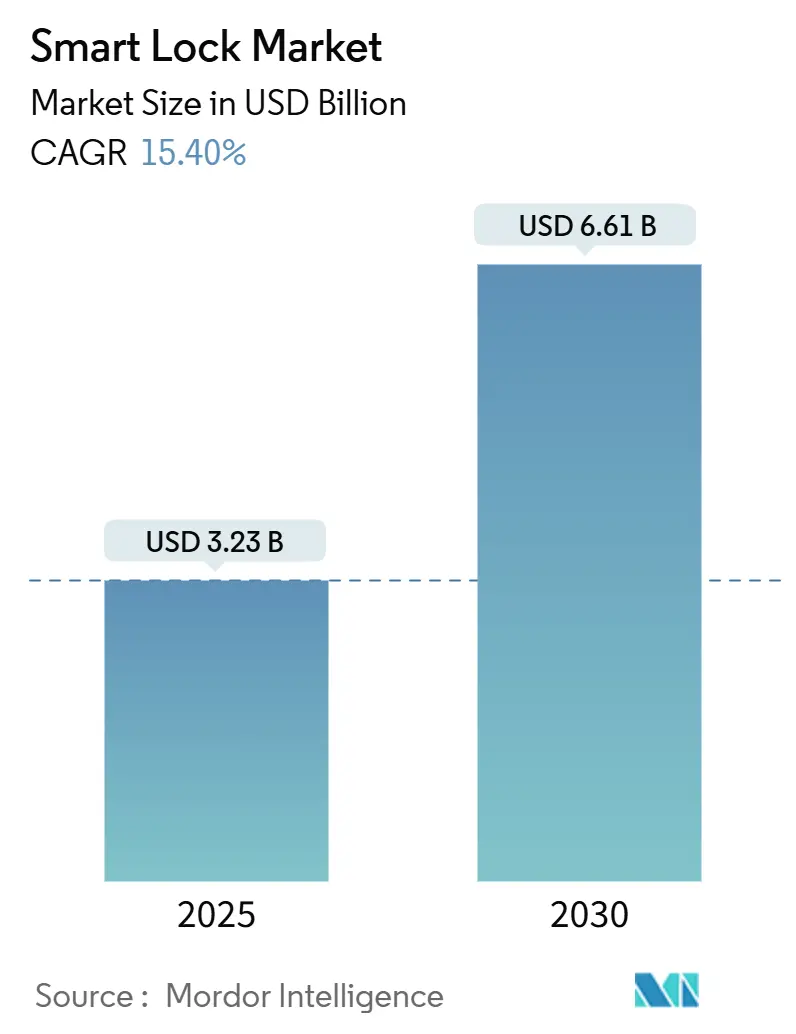
Smart Lock Market Analysis by Mordor Intelligence
The smart lock market stands at a valuation of USD 3.23 billion in 2025 and is forecast to reach USD 6.61 billion by 2030, reflecting a 15.40% CAGR. The outlook highlights the convergence of maturing smart-home platforms, rising urban security concerns, and expanding IoT connectivity that favors remote door access. Interoperability progress through the Matter and Thread standards now removes many integration barriers, while declining biometric sensor prices are broadening feature sets across both residential and light-commercial models. Price increases linked to semiconductor shortages are a near-term headwind, yet insurance premium discounts and total-cost-of-ownership savings continue to encourage replacement of mechanical locks. Intensifying acquisition activity shows established access-control leaders positioning to secure scale, channel reach, and core technology.
Key Report Takeaways
- By lock type, deadbolts led with 45.7% revenue share in 2024; lever handle systems are projected to advance at a 15.6% CAGR to 2030.
- By communication technology, Bluetooth held 62.3% of smart lock market share in 2024, while Zigbee-based solutions are poised to expand at 17.2% CAGR through 2030.
- By authentication method, keypads captured 42.7% of the smart lock market size in 2024; biometrics is set to grow at a 17.7% CAGR between 2025-2030.
- By end-user application, residential installations accounted for 57.9% of revenue in 2024; hospitality and short-term rentals are expected to register the fastest 17.1% CAGR to 2030.
- By geography, North America dominated with 37.7% share in 2024, whereas Asia-Pacific is forecast for a 15.9% CAGR through 2030.
Global Smart Lock Market Trends and Insights
Drivers Impact Analysis
| Driver | (~) % Impact on CAGR Forecast | Geographic Relevance | Impact Timeline |
|---|---|---|---|
| Rapid adoption of smart-home ecosystems | +3.20% | Global, with North America and Europe leading | Medium term (2-4 years) |
| Rising burglary and safety concerns in urban areas | +2.80% | Global, concentrated in urban centers | Short term (≤ 2 years) |
| Smartphone and IoT proliferation enabling remote access | +2.50% | Global, with Asia-Pacific showing highest growth | Long term (≥ 4 years) |
| Building-code push for keyless energy-efficient doors | +1.90% | North America and Europe primarily | Long term (≥ 4 years) |
| Airbnb-style rentals demanding automated guest access | +2.10% | Global, concentrated in tourism hubs | Medium term (2-4 years) |
| Home-insurance premium discounts for connected locks | +1.40% | North America and Europe | Medium term (2-4 years) |
| Source: Mordor Intelligence | |||
Rapid Adoption of Smart-Home Ecosystems
Growing preference for unified device control makes smart lock integration one of the first upgrades in connected homes. Matter-over-Thread launches by Yale, Schlage, and Level are removing vendor lock-in and extending battery life to more than 12 months. Voice assistants already reside in 70% of United States households, which accelerates voice-enabled locking. Scheduled Thread 1.4 adoption by 2026 will let new products join existing networks without additional hubs, further tightening ecosystem stickiness.[1]YaleHome,"Yale Announces New Matter over Thread Deadbolt Lock," yalehome.com
Rising Burglary and Safety Concerns in Urban Areas
Urban crime patterns have raised homeowner vigilance, and data show 83% of burglars survey security setups before entry. Integrating a smart lock with video verification closes the 15-second alarm response gap common in legacy systems. Lockly’s facial recognition engine now flags unauthorized faces in 1.5 seconds, sending real-time alerts that deter opportunistic crime. Multi-factor combinations of biometrics and PINs add layered protection for dense residential high-rises where anonymity often aids break-ins.
Smartphone and IoT Proliferation Enabling Remote Access
Smartphone penetration exceeds 85% in developed markets, delivering the control interface critical to the smart lock market. Rollout of 5G networks minimizes latency for cloud-managed unlocking, while ultra-wideband chips enable proximity-based doors that auto-open for registered users. Digital wallet integration is emerging, letting the same credential verify payments and physical entry. For example, NEC's biometric systems deployed at Expo 2025 in Osaka demonstrate how smart locks can facilitate both access control and cashless payment processing. [2]NEC,"NEC Biometrics: No Cards, No Keys, No Problem," nec.com Matter certification now guarantees interoperability so property owners can mix devices while still using a single mobile app.
Building-Code Push for Keyless Energy-Efficient Doors
Recent building regulations require electronic locks in several large metropolitan projects to track occupancy and automate HVAC and lighting. Studies show smart locks integrated with building systems cut energy use by 15-20%. ADA requirements also favor touch-free entry that assists elderly users, leading to higher adoption in senior housing. LEED scoring has begun awarding credits for connected access control, making smart locks part of sustainability checklists on new builds.
Restraints Impact Analysis
| Restraint | (~) % Impact on CAGR Forecast | Geographic Relevance | Impact Timeline |
|---|---|---|---|
| Cyber-security and hacking vulnerabilities | -2.10% | Global, with higher impact in security-conscious markets | Short term (≤ 2 years) |
| Up-front device and installation cost premium | -1.80% | Global, with higher impact in price-sensitive markets | Medium term (2-4 years) |
| Battery-life / maintenance anxieties among consumers | -1.20% | Global, particularly in residential applications | Medium term (2-4 years) |
| Inter-protocol interoperability gaps in retrofit projects | -0.90% | North America and Europe primarily | Short term (≤ 2 years) |
| Source: Mordor Intelligence | |||
Cyber-Security and Hacking Vulnerabilities
High-profile breaches have exposed biometric bypasses and cloneable NFC tags in mainstream models. Tests by one consumer association found 85.7% of chip-activated units exhibited at least one critical flaw. Vendors now ship end-to-end encryption and two-factor log-ins, yet fragmented hardware designs make universal patching hard to maintain. Industry groups within the Connectivity Standards Alliance are drafting baseline requirements, but wide variation in implementation keeps cyber-risk elevated.
Up-Front Device and Installation Cost Premium
Smart locks typically retail between USD 200-800, while traditional deadbolts cost USD 50-150. Professional installation of USD 100-200 further raises the barrier. Tariff pass-through and semiconductor shortages have pushed list prices up to 10% higher during 2024-2025. Subscription models such as Centrios’ free tier for five openings hint at new pricing tactics that may soften the impact, yet entry-level households in emerging markets still view the replacement decision as discretionary.[3]Secura, "Security concerns in popular smart home devices," secura.com
Segment Analysis
By Lock Type: Deadbolts Maintain Familiarity While Lever Handles Accelerate
Deadbolts retained 45.7% of 2024 revenue, reflecting widespread homeowner confidence in their physical robustness. This share equates to the largest slice of the smart lock market size for hardware formats. Lever handle systems achieved the leading 15.6% CAGR due to ADA compliance needs in hotels and offices, demonstrating how ease-of-operation appeals to high-traffic settings.
Consumers seeking discreet upgrades have driven interest in retrofit cylinders that hide electronics inside existing housings, exemplified by Level’s invisible mechanism. Padlock-style smart devices service out-door industrial use cases but remain niche because of weather-proofing costs. Continuous miniaturization will likely blur category boundaries, though deadbolts are expected to keep a commanding presence through 2030 in the smart lock market.
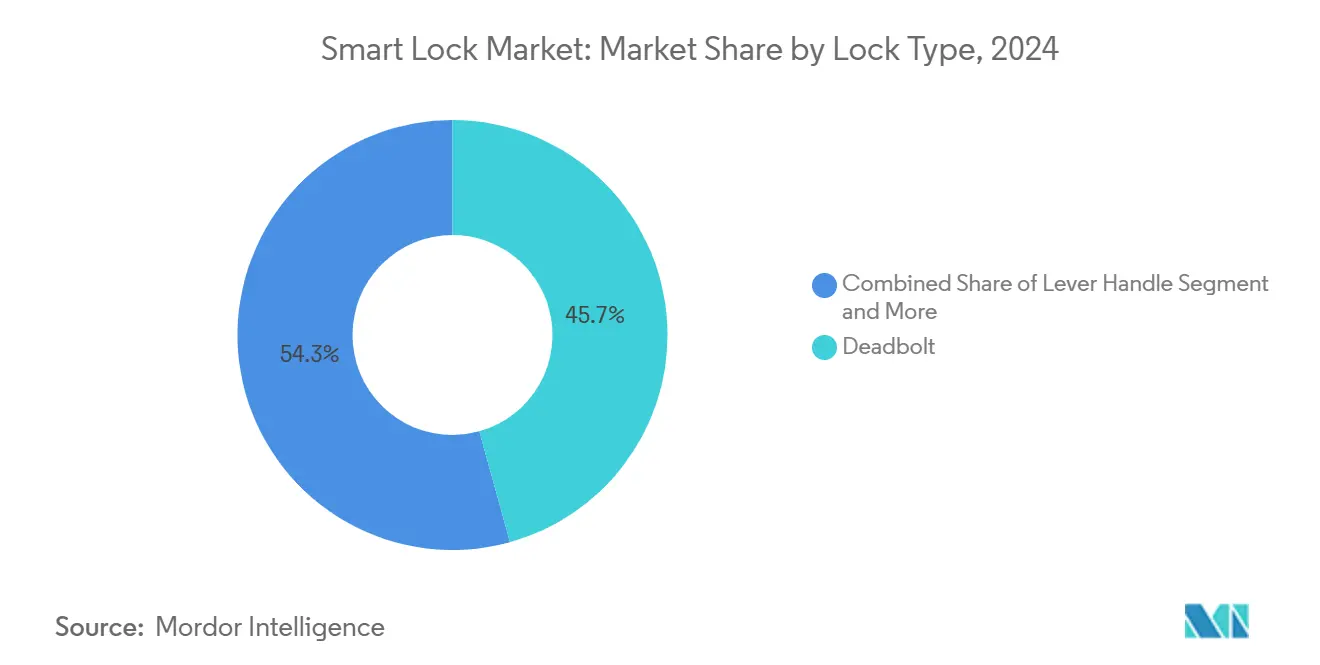
Note: Segment shares of all individual segments available upon report purchase
By Communication Technology: Zigbee and Thread Outpace Legacy Bluetooth
Bluetooth held 62.3% share in 2024, translating into the top position within the smart lock market share for connectivity. Its phone-to-lock pairing simplicity favors rental properties where router access is uncertain. Range and mesh limitations, however, make it less suited to multi-unit dwellings.
The Zigbee-Thread stack is projected for a 17.2% CAGR, propelled by Matter certification and Silicon Labs’ ultra-low-power SoCs. Wi-Fi continues in cloud-first deployments that prioritize direct remote control despite battery drain. Emerging ultra-wideband adds hands-free precision but sits within the “Others” bucket until shipping volumes scale. Across protocols, standardization is shrinking fragmentation, a trend that will raise the overall smart lock market adoption curve.
By Authentication Method: Biometrics Challenge Keypads
Keypads produced the largest 42.7% revenue slice in 2024 and thus dominate the smart lock market size for credentials. Users appreciate code familiarity and backup battery life. Nonetheless, shared codes and manual entry inconvenience check keypad growth.
Biometric units log a 17.7% CAGR as camera, sensor, and AI costs drop. Facial recognition unlocks now complete in under 1.5 seconds at 99.9% accuracy, bringing premium-grade convenience into mid-price models. RFID and NFC cards remain common in offices requiring audit trails, while mobile credential use gains ground where bring-your-own-device policies prevail. Biometric progress is expected to reset user expectations and propel higher-spec differentiation across the smart lock market.
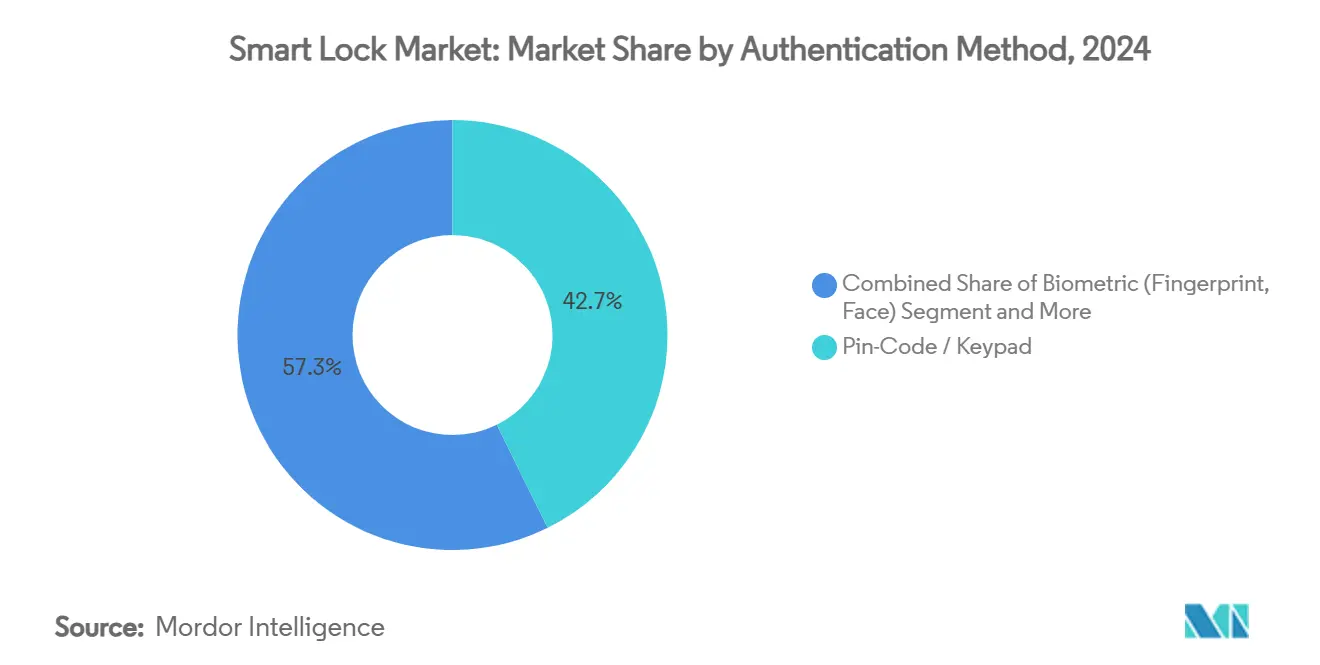
Note: Segment shares of all individual segments available upon report purchase
By End-User: Hospitality Gains Momentum
Residential buyers generated 57.9% of 2024 revenue, making homes the anchor of the smart lock market. Builders increasingly bundle connected locks to stand out in competitive housing markets. Parents use temporary codes for service providers, reinforcing convenience value.
Hospitality and short-term rentals will witness the fastest 17.1% CAGR, led by self-check-in mandates that arose during the pandemic. Properties cut staffing costs and improve guest satisfaction by replacing keycards with phone credentials. Commercial offices upgrade to integrate visitor logs with desk-booking tools, while industrial facilities prioritize ruggedized enclosures. The broadening scenario expands total addressable demand and sustains double-digit growth in the smart lock market.
Geography Analysis
North America secured 37.7% of 2024 revenue due to early smart-home adoption, favorable codes, and insurance discounts of up to 10% for connected security. The United States drives renovation demand as developers view smart locks as standard amenity packages. Canada follows, leveraging similar building norms and broadband penetration.
Asia-Pacific is set for the highest 15.9% CAGR, reflecting rapid urban migration and growing middle-class disposable income. China leads smart-home shipments, while India’s residential automation pipeline shows a 39.79% expansion outlook that positions smart locks near the top of consumer upgrade lists. Japan’s aging demographic attracts contactless door solutions supporting senior independence.
Europe posts steady progression anchored by energy-efficiency directives and strong privacy oversight. Advanced encryption requirements raise development costs yet promote differentiated offerings that comply with GDPR. The Middle East and Africa, though smaller today, benefit from smart-city investments baked into greenfield real-estate projects, enabling leapfrog adoption paths that raise the future baseline of the smart lock market.
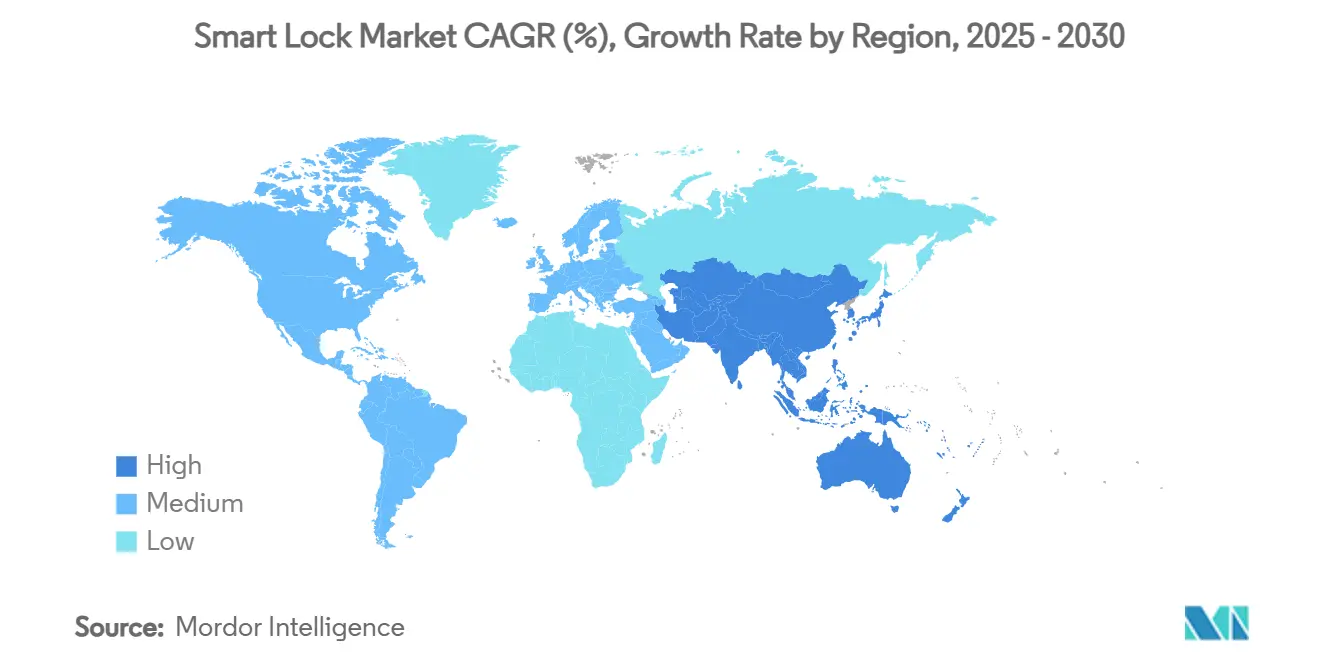
Competitive Landscape
The field remains moderately fragmented: the top five suppliers account for roughly one-third of global revenue, leaving room for fast-moving specialists. ASSA ABLOY integrates Yale, August, and HID to address multiple price tiers, while Allegion builds on Schlage’s residential reach and Von Duprin’s commercial roots. Spectrum Brands leverages the Kwikset and Baldwin portfolios, and dormakaba balances hospitality leadership with Swiss engineering credibility.
Acquisition strategies show two patterns. Horizontal moves expand channel breadth, as seen in ASSA ABLOY’s purchase of Level Lock for USD 16 million. Vertical steps secure technology and premium branding: Fortune Brands paid USD 800 million for Yale and August to deepen connected-products scale. Challenger brands Lockly, U-TEC, and Nuki differentiate with fast biometric innovation and early Matter certification. Consumer-electronics giants Samsung and Xiaomi harness existing IoT ecosystems to enter the smart lock market on favorable cost curves, pressuring mid-tier incumbents.
Standards alliances further shape rivalry. Apple, Google, and Samsung introduced the Aliro smartphone credential, which could erode physical key reliance and shift bargaining power toward mobile-OS owners. To stay competitive, legacy firms increasingly bundle cloud platforms and analytics, turning hardware sales into recurring-revenue gateways that stabilize margins in the smart lock market.
Smart Lock Industry Leaders
-
ASSA ABLOY (Yale, August)
-
Allegion plc (Schlage)
-
Spectrum Brands Holdings (Kwikset)
-
dormakaba Group
-
Honeywell International
- *Disclaimer: Major Players sorted in no particular order
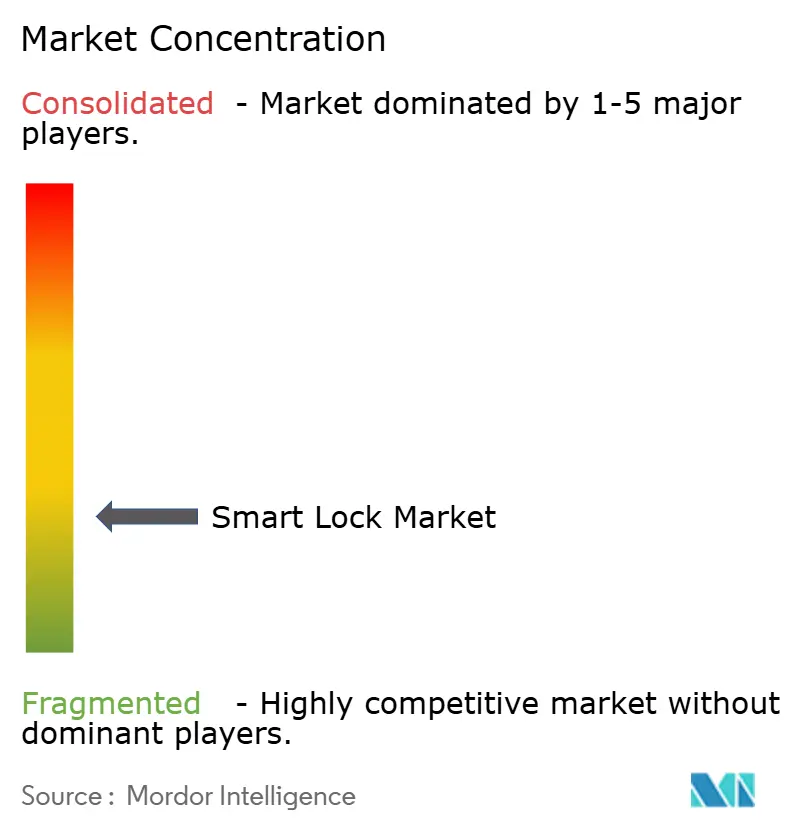
Recent Industry Developments
- July 2025: Bitkey completed a 1,000-unit deployment across rental properties run by Sanfuku Management Center in Japan.
- April 2025: ASSA ABLOY launched Centrios, a small-business access platform with a free tier for five openings.
- March 2025: Eufy published installation-cost guidance showing professional fees of USD 100-200 per unit.
- March 2025: Yale unveiled a Matter-over-Thread deadbolt supporting lower standby power budgets.
Global Smart Lock Market Report Scope
A smart lock is an electromechanical locking device that enables users in various industries to remotely access and unlock the lock to enter the premises. It can be accessed by connecting it to smartphones and other smart devices through various communication technologies like Wi-Fi, Bluetooth, Zigbee, or Z-Wave. It allows remote authentication to verified and authorized users.
The Smart Lock Market is Segmented By Communication Technology (Wi-Fi, Bluetooth, Zigbee, Z-Wave), Authentication Methods (Biometric, Pin Code, RFID Cards), End-user Applications (Commercial, Residential, Educational Institutes & Government, Industrial), and Geography (North America, Europe, Asia-Pacific, and Rest of the World).
The market sizes and forecasts are provided in terms of value (USD million) for all the above segments.
| Deadbolt |
| Lever Handle |
| Padlock |
| Others |
| Bluetooth |
| Wi-Fi |
| Zigbee |
| Others |
| Pin-Code / Keypad |
| Biometric (Fingerprint, Face) |
| RFID / NFC Card |
| Others |
| Residential |
| Commercial Offices |
| Hospitality and Short-term Rentals |
| Industrial and Infrastructure |
| North America | United States | |
| Canada | ||
| Mexico | ||
| South America | Brazil | |
| Argentina | ||
| Rest of South America | ||
| Europe | Germany | |
| United Kingdom | ||
| France | ||
| Italy | ||
| Spain | ||
| Rest of Europe | ||
| Asia-Pacific | China | |
| Japan | ||
| India | ||
| South Korea | ||
| Southeast Asia | ||
| Rest of Asia-Pacific | ||
| Middle East and Africa | Middle East | Saudi Arabia |
| United Arab Emirates | ||
| Turkey | ||
| Rest of Middle East | ||
| Africa | South Africa | |
| Nigeria | ||
| Egypt | ||
| Rest of Africa | ||
| Egypt | ||
| Rest of Africa | ||
| By Lock Type | Deadbolt | ||
| Lever Handle | |||
| Padlock | |||
| Others | |||
| By Communication Technology | Bluetooth | ||
| Wi-Fi | |||
| Zigbee | |||
| Others | |||
| By Authentication Method | Pin-Code / Keypad | ||
| Biometric (Fingerprint, Face) | |||
| RFID / NFC Card | |||
| Others | |||
| By End-user | Residential | ||
| Commercial Offices | |||
| Hospitality and Short-term Rentals | |||
| Industrial and Infrastructure | |||
| By Geography | North America | United States | |
| Canada | |||
| Mexico | |||
| South America | Brazil | ||
| Argentina | |||
| Rest of South America | |||
| Europe | Germany | ||
| United Kingdom | |||
| France | |||
| Italy | |||
| Spain | |||
| Rest of Europe | |||
| Asia-Pacific | China | ||
| Japan | |||
| India | |||
| South Korea | |||
| Southeast Asia | |||
| Rest of Asia-Pacific | |||
| Middle East and Africa | Middle East | Saudi Arabia | |
| United Arab Emirates | |||
| Turkey | |||
| Rest of Middle East | |||
| Africa | South Africa | ||
| Nigeria | |||
| Egypt | |||
| Rest of Africa | |||
| Egypt | |||
| Rest of Africa | |||
Key Questions Answered in the Report
What is the current size of the smart lock market?
The smart lock market is valued at USD 3.23 billion in 2025.
How fast will the smart lock market grow through 2030?
Revenue is forecast to expand at a 15.40% CAGR, reaching USD 6.61 billion by 2030.
Why is Asia-Pacific the fastest-growing region?
Rapid urbanization, rising disposable income, and extensive smart-city programs drive a 15.9% CAGR across Asia-Pacific through 2030.
What factor most constrains adoption?
Up-front costs remain the main barrier, as smart locks and installation can be four times the price of mechanical alternatives.
Page last updated on:



